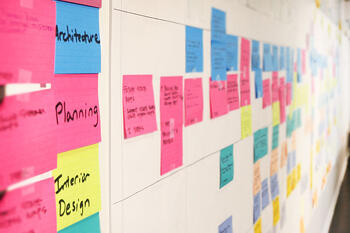In today’s healthcare climate, providers, focused on the cost of care relative to patient outcomes, face the challenge to increase the quality and accessibility of care with resource constraints. Deloitte and Array have long collaborated to organize roundtable events that encourage knowledge sharing and interactive discussions, and this challenge seems to be a topic that is keeping Washington, DC healthcare institutions’ leaders awake at night. This resulted in the decision to coordinate a discussion around it in first quarter 2016, inviting both government and non-profit healthcare entities. The event kicked off with a healthcare policy legislative update beforethe group delved into an exchange regarding how hospital leaders are responding to limited capital and finding successful ways to maximize their facility assets through lean process improvement.

LEAN IN HEALTHCARE DESIGN
The healthcare design and construction industry has adopted the term “lean”, which traces back to Toyota’s philosophy, in recent years. The vehicle manufacturer’s lean methodology of eliminating waste completely through their Just-in-Time process resulted in a transformation of the manufacturing industry, which then birthed an idea for healthcare. Cutting waste and being more efficient at a time when capital dollars are being squeezed more than ever, healthcare institutions are adopting ways to streamline their processes.
Toyota’s first step was to define value. After deciding on speed to the customer as the core value, Toyota defined principles. It would be great if we could apply that same ideology to our industry. How can we apply lean to facility development, and how can we use lean to ask, “What should the project even be?” Once you start with that goal, it would make decision-making very simple by weighing the pros and the cons of each option and then choosing by advantages. Some healthcare professionals, however, aren’t sold on the theory of lean working because healthcare services aren’t a product like the one Toyota has, but rather a service. People receive treatment; therefore, it can’t be standardized.
 Another apprehension is how lean is mostly about improving what health systems and hospitals already have rather than helping them to create things that don’t already exist. Healthcare Systems Engineers are becoming more prevalent within organizations. These quality leaders have large loads on their plates and often don’t have the resources to dedicate a team to a new capital project. At the same time, strong market competition adds time pressures to facility project teams who need to deliver quickly. This is why speed and accuracy are at odds from day one, and it’s an ongoing struggle. If a building is designed and built really fast, how much do we get wrong?
Another apprehension is how lean is mostly about improving what health systems and hospitals already have rather than helping them to create things that don’t already exist. Healthcare Systems Engineers are becoming more prevalent within organizations. These quality leaders have large loads on their plates and often don’t have the resources to dedicate a team to a new capital project. At the same time, strong market competition adds time pressures to facility project teams who need to deliver quickly. This is why speed and accuracy are at odds from day one, and it’s an ongoing struggle. If a building is designed and built really fast, how much do we get wrong?
Lean plays a large role when addressing the issues above. It can act as a decision-support approach, allowing teams to scenario test and quickly evaluate different options. What will happen if we do this versus that? What if we use centralized versus decentralized check-in?
WHERE DC ORGANIZATIONS ARE TODAY
Systems are beginning to embark on a lean journey, and the attendees shared their exploration journey with their counterparts:
- Lean is becoming visible within the hospital, but there often seems to be a waiting period before incorporating into Facilities Management.
- Rapid improvement events are being completed in clinical areas.
- A3 thinking is starting to happen: leading organizations implement it in operations and at the strategic level.
- Developing Process Improvement Departments and trying to be value-stream-focused by looking at various components of the business is gaining momentum: patient flow and throughput; budgeting and forecasting; and, a laser-focused look at services such as lab, pharmacy and emergency.
- The initial focus is on Continuous Improvement initiatives: streamlining processes and optimizing departments.
- Undergoing deep analyses of key indicators such as hospital size and number of beds.
- Thinking about how pushing services to an ambulatory setting would benefit finances and operations.
HOW DO PRESSURES FROM HEALTHCARE REFORM TRANSLATE TO PROJECT DELIVERY?
Healthcare Reform changes at a rapid pace, causing the staff to have a tough time visualizing a new way of accomplishing a task. Coupling that with the extreme pressure to be the first to market and build facilities fast, the team asked itself “What is the real value of what we’re trying to do?” The following bullets outline additional issues the group brought up regarding their struggles with implementing healthcare reform in the care environment:
- Funding slows speed-to-market goals for desired system improvements.
- There are large-scale challenges and more focused challenges, each involving different layers of the organization. Are the improvement efforts being communicated through all the ranks and departments? Are the focused efforts fitting into the systemic goals? Is everyone rowing in the right direction?
- We are trying to define answers without perhaps knowing what the customer is looking for.
- In the healthcare industry, we sometimes look at a small representative sample and try to base decisions on that.
- People get nervous if they’re not utilizing capacity, even when overall system optimization is efficient.
HOW THIS LENDS TO DESIGN AND CONSTRUCTION CHALLENGES:
Capital dollars are being squeezed. The pre-design phase is often eliminated—an expense that clients don’t want to pay for—yet, this front-end information is very much needed to make strategic and transformative decisions. Spending the extra dollars up front is hard to quantify, but will result in a better project. As it stands now, clients expect design teams to just start and put programming into schematic design. The roundtable discussion also included the following topics:
- The lack of an up-front analysis is also a missed opportunity when it comes to looking at volumes, market share, and population-health-referral bases. This is important information to have prior to making facility decisions, yet hospitals often have a hard time determining the value of it to see it as worthwhile.
- Lean studies and principles are more involved at the green apple level, but perhaps projects should start with lean as the fruit. What is the risk if we don’t do the early work? Moreover, what’s the risk if we do?
- What are the Key Performance Indicators (KPI)? As of now, we struggle to measure lean. What decisions led to notable improvements, and which should we stay away from in the future? How can we develop goals and use tools to measure outcomes?
- Going to industry events make you realize that everyone isn’t necessarily on the same page, but rather operating in silos.
A FEW RECOMMENDATIONS:
- Anticipate needs that are important to the stakeholders and clients early on, similar to the hospitality sector.
- Make sure that information is universally available so that everyone has all of the information at the same time.
- Define value before you define a project: ASK EARLY!
It’s a cultural shift for us to trust the process. Clients often expect architects to have answers to their challenges, but the way to get the most successful results is to get the right stakeholders together and learn every aspect of their goals. This will lead to a better result and an appropriately sized, service-rich building — a much-improved space than what we would have designed without the input.
Click the button below to learn how Lean and other continuous improvement tools can help your organization.
Blog authored by Jennifer O’Donnell, a former VP, Business Development at Array.

